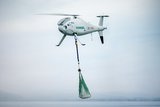Ampex introduces TuffServ 40 airborne recorder
Ampex Data Systems has unveiled the newest addition to its TuffServ ruggedised ultra compact airborne recorder family, the TuffServ 40 (TS 40). Ampex made the announcement in a 16 January 2012 company statement.
At just 1.8" H x 3.5" W x 6.25" D and weighing 1.4 lbs, the TS 40 is the smallest, lightest and most power-frugal member of the TuffServ family. The system is specifically designed for demanding applications such as tactical Unmanned Aerial Systems (UAS) where size and payload weight are at a premium. Using a fixed solid-state storage module, the TS 40 provides up to 160GB of memory with larger capacities available in the future.
According to the company, the standard system is delivered with a modern Linux system, providing a wide range of network services out of the box, including NFS and Samba for Windows SMB/CIFS networks, FTP and iSCSI.
More from Uncrewed Vehicles
-
Jammer resistant drone designs spark search for countermeasures
The Russia-Ukraine conflict has driven another stage of evolution for drones and the counter measures to defend against them.
-
![L3Harris launches Amorphous software for control of uncrewed platforms]()
L3Harris launches Amorphous software for control of uncrewed platforms
The new Amorphous software is a universal controller that would allow a single operator to control a swarm of “thousands” of uncrewed systems, from drones to underwater platforms.
-
ideaForge unveils new UAVs at Aero India 2025
India UAV supplier ideaForge has launched the Netra 5 and Switch V2 drones at Aero India 2025, boasting of enhanced endurance, AI-driven autonomy and improved operational capabilities.
-
![Shaping the future of defence: What 2025 holds for the global drone market]()
Shaping the future of defence: What 2025 holds for the global drone market
The UAV market is experiencing unprecedented growth, with innovations in technology and battlefield applications driving demand across military sectors. From the battlefields of Ukraine to NATO exercises and beyond, drones are transforming how wars are fought and supported.
-
![Maris-Tech confirms customers signing up for Jupiter Drones codec and AI-powered system]()
Maris-Tech confirms customers signing up for Jupiter Drones codec and AI-powered system
Launched at AUSA in October, the company’s multi-stream video codec is attempting to bring a new lease of life to drone technology through its AI accelerator.
-
![AUSA 2024: Quantum-Systems targets big 2025 with UAS developments]()
AUSA 2024: Quantum-Systems targets big 2025 with UAS developments
Quantum-Systems has been upgrading its UAS family, with new versions of the Vector, Reliant and Twister drones set for release throughout 2025.
























